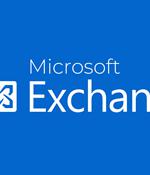Security News

Microsoft has confirmed that two recently reported zero-day vulnerabilities in Microsoft Exchange Server 2013, 2016, and 2019 are being exploited in the wild. "At this time, Microsoft is aware of limited targeted attacks using the two vulnerabilities to get into users' systems."

Security researchers are warning of previously undisclosed flaws in fully patched Microsoft Exchange servers being exploited by malicious actors in real-world attacks to achieve remote code execution on affected systems."We detected webshells, mostly obfuscated, being dropped to Exchange servers," the company noted.

Security researchers have warned a zero-day flaw in Microsoft's Exchange server is being actively exploited. A second flaw, ZDI-CAN-18802, is rated 6.3/10. "Details of the flaws are scanty, with GTSC's post detailing its observations of webshells with Chinese characteristics being dropped onto Exchange servers. Those webshells then"injects malicious DLLs into the memory, drops suspicious files on the attacked servers, and executes these files through the Windows Management Instrumentation Command line.

Threat actors are exploiting yet-to-be-disclosed Microsoft Exchange zero-day bugs allowing for remote code execution, according to claims made by security researchers at Vietnamese cybersecurity outfit GTSC, who first spotted and reported the attacks. The researchers reported the security vulnerabilities to Microsoft privately three weeks ago through the Zero Day Initiative, which tracks them as ZDI-CAN-18333 and ZDI-CAN-18802 after its analysts validated the issues.

Threat actors are exploiting yet-to-be-disclosed Microsoft Exchange zero-day bugs allowing for remote code execution, according to claims made by security researchers at Vietnamese cybersecurity outfit GTSC, who first spotted and reported the attacks. The researchers reported the security vulnerabilities to Microsoft privately three weeks ago through the Zero Day Initiative, which tracks them as ZDI-CAN-18333 and ZDI-CAN-18802 after its analysts validated the issues.

Threat actors are exploiting yet-to-be-disclosed Microsoft Exchange zero-day bugs allowing for remote code execution, according to claims made by security researchers at Vietnamese cybersecurity outfit GTSC, who first spotted and reported the attacks. Microsoft hasn't disclosed any information regarding the two security flaws so far and is yet to assign a CVE ID to track them.

Microsoft next month will start phasing out Client Access Rules in Exchange Online - and will do away with this means for controlling access altogether within a year. CARs are being replaced with Continuous Access Evaluation for Azure Active Directory, which can apparently in "Near-real time" pick up changes to access controls, user accounts, and the network environment and enforce the latest rules and policies as needed, according to a notice this week from Microsoft's Exchange Team.

Microsoft announced today that it will retire Client Access Rules in Exchange Online within a year, by September 2023. CARs are sets of conditions, exceptions, actions, and priority values that allow Microsoft 365 admins to filter client access to Exchange Online based on many factors.

Multiple npm packages published by the crypto exchange, dYdX, and used by at least 44 cryptocurrency projects appear to have been compromised. The packages in question were published from the npm account of a dYdX staff member and found to contain illicit code that would run info stealers on a system when installed.

Microsoft says a threat actor gained access to cloud tenants hosting Microsoft Exchange servers in credential stuffing attacks, with the end goal of deploying malicious OAuth applications and sending phishing emails. "The unauthorized access to the cloud tenant enabled the actor to create a malicious OAuth application that added a malicious inbound connector in the email server."